The most unpleasant symptoms, in the form of itching and rashes, can cause subcutaneous parasites in people of all ages. Any invasion leads to many health problems due to complications. Especially dangerous are species of worms with a long incubation period of several months.
<1_img_centerxx>Types of parasites living under the skin
A subcutaneous worm can enter the human body: through tactile contact with infected people; blood-sucking insects carrying larvae of animal parasites.
The main feature of such an invasion is the difficulty in recognizing the pathology, since at first the infection can be disguised as other somatic diseases.
Having caught itself under the thickness of the skin, the parasite is able over time to move to all internal organs and cause their functional disorders. Helminths feed on blood and use it to hatch larvae.

The main signs of the presence of this type of parasites in the body are severe weakness, decreased performance, a constant desire to scratch the skin. When these signs appear, it is advisable to consult a specialist: therapist, dermatologist, allergist, infectious disease specialist. The joint work of doctors and the diagnostic methods they use in their work help to recognize in time the presence of a subcutaneous invasion in the body.
Among the diagnostic methods, studies of scrapings of stool, blood, scalp and epidermis are mandatory.
The most common infection with subcutaneous helminths occurs in countries with a very hot climate - Central Asia, Africa, South America. Therefore, when returning from tourist trips across continents, you should pay special attention to your health.
Important! It is strictly forbidden to self-medicate with medical and folk remedies - it can aggravate the situation and poison the body. It is necessary not to delay the visit to the doctor and strictly follow the prescribed drug treatment.
There are many types of worms that live in the skin. The invasive species listed below are the main ones.
Filariasis
The subcutaneous helminths of this species are represented by filamentous nematodes, common in tropical states. This type of parasite can live in the skin for several years in a row, and after its own adaptation, it migrates through the body and seeks another habitat.
The signs of the disease that appear early are rashes in the form of hives and spots, accompanied by itching. Then the temperature is added.
Serious signs of filariasis include eczema, ulcers and warts, subcutaneous nodules, severe headache, drowsiness, subcutaneous nodules, and increased fever.
Often the parasite can be found during an examination by an ophthalmologist, as it likes to live in the mucous membrane of the eye.
Important! With an untimely visit to the doctor, filariasis contributes to the development of eye diseases and leads to complete loss of vision.
Schistosomiasis
The parasite of this species lives in rivers and warm freshwater lakes in countries with hot climates. Infection can occur by bathing or drinking raw water.
The parasite simultaneously affects the skin and the urinary system. Toxic substances entering the blood strongly poison the body, which leads to various disturbances in the work of many organs and systems.
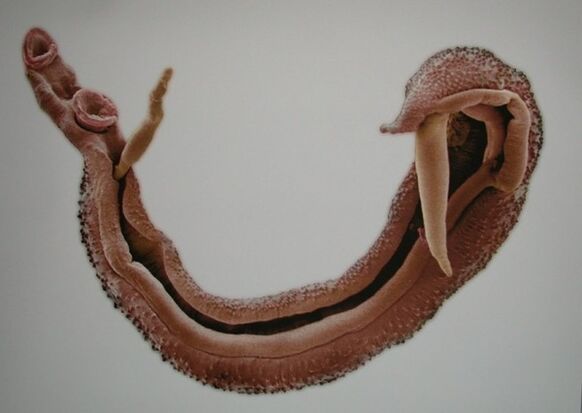
Signs of infection with a parasite are: a rash in the form of dermatitis and redness on the skin, unbearable itching, night sweats, enlarged liver, functional disorders of the renal system, a sudden rise in temperature.
Schistosomiasis, which occurs with damage to the genitourinary system, obstructs the outgoing and incoming ducts of the bladder.
Important! In order not to get infected with this helminth, you cannot swim in stagnant bodies of water in the tropics and drink raw water from unknown natural sources.
Dracunculiasis
The disease is caused by rishta - parasitic roundworms, reaching a length of 80 cm. Infection with worms, which are home to countries with tropical climates and Central Asia, can be due to the use of raw water or contact with cats and dogs carrying the worm.
The incubation period from the moment of infection with the eggs of the parasite and migration through the body is 1. 5 months. Parasites grow and develop throughout the year.
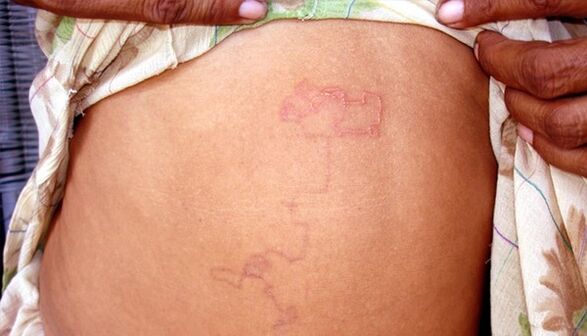
Dracunculiasis mainly affects the skin of the lower limbs. The parasite is able to twist and unfold, forming a long bulge on the skin, and then a bubble of several centimeters. As soon as the bubble comes in contact with water, it immediately bursts, releasing the larvae, which cause symptoms of severe internal itching.
Important! If treatment and control of this type of parasite is not carried out, the person begins to develop sepsis, gangrenous inflammation or immobility of the joints.
Scabies
The type of mites up to 0. 4 mm is the culprit in the development of scabies. Parasites can be infected through contact with the sick person's body or their belongings, if the person has severely reduced immunity. Infection occurs when hygiene rules are not followed.
Small parasites that enter the skin are introduced first into the epidermis, then into the deep layer, and are able to infect the whole body with toxins. The parasites eat away the passages in which they lay eggs.
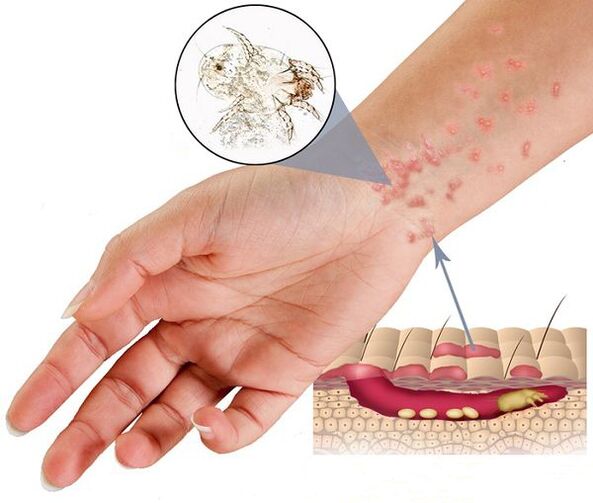
Clinical symptoms of the pathology appear in the form of a red rash, small blisters and peeling of the skin on: hands, thighs, elbows, knees and hair. If you treat the areas of the rashes with iodine solution, you can see ticks.
Due to the active development and reproduction of the parasite, a person is tormented by intolerable itching, which intensifies at night, the desire to scratch the skin, as well as after contact with water.
Complications of scabies include the development of furunculosis, eczema, dermatitis, and vesicular lesions on the skin.
Important! In order not to catch scabies, you must adhere to the rules of hygiene and avoid contact with people infected with scabies.
Demodecosis
This disease, caused by a microscopic mite, is seasonal in nature and most often appears in the fall. The formation of excess fat on the skin in summer and the negative effects of ultraviolet rays undermine local immunity, contributing to the spread of this species of mite.
Parasites can be infected through tactile contact with a sick person, as well as through the use of personal belongings and care items.
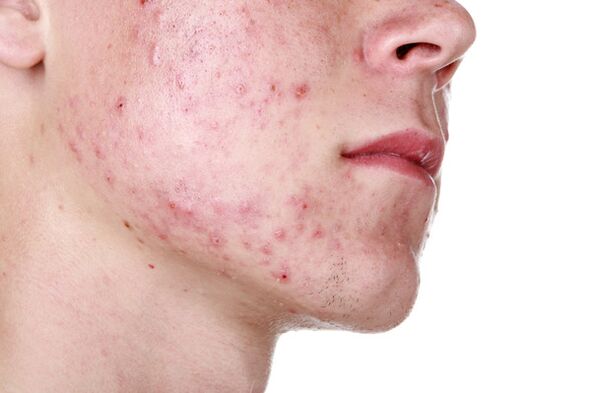
The pathology, according to clinical signs, is very close to acne, which is seizing more and more territories. Pink and red papules abundantly dot the face and back, leaving rough scars after healing. A person can develop inflammation of the eyelids, vasodilation, and peeling of the eyebrows.
Important! Demodectic mange develops over the years. For an accurate diagnosis of a person, a scraping is taken from the skin. Healing therapy can take up to 3 months.
Heartworm
The invasion is considered a dangerous parasitic disease, caused by heartworms, reaching 30 cm in adulthood. This type of parasite affects areas under the skin, as well as eye tissue, and can cause complete loss of vision.
The incubation period for the development of heartworm is several years. A person can be infected by the bite of mosquitoes, which carry parasite eggs from sick dogs and cats.
A seal develops in the skin, accompanied by pain, unbearable itching and hyperemia. The seal can grow to the size of an average egg, in which the coiled helminth lives.
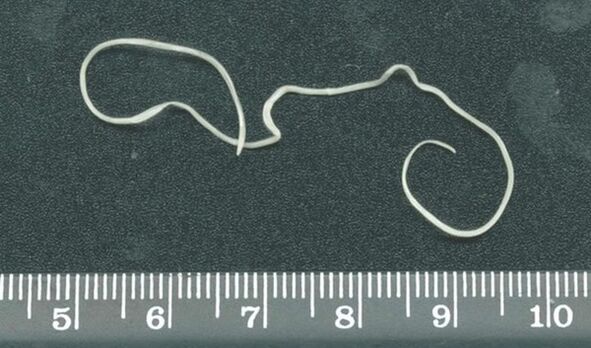
Basically, the parasite lives in the skin, but it can sometimes crawl into the eye, resulting in visual impairment and loss of vision.
In order not to get infected with this type of worm, you should fight mosquitoes by all possible methods and use repellents on a daily basis.
How to get rid of subcutaneous parasites?
The fight against worms developing under the skin is based on the use of superficial and medicinal methods, as well as surgical operations.
Antiparasitic therapy for each type of helminth can be presented in tabular form:
In most cases, you can get rid of subcutaneous types of helminths with surgery and intensive chemotherapy.
Surface treatment
Superficial action methods are used to control helminths that live in the epidermis (eg, scabies and demodicosis).
External antiparasitic drugs are rubbed into the skin with scabies. These drugs are rubbed all over the body at night. The course lasts 2 weeks. People who have been in contact with an infected person are advised to perform the same procedures.
With demodicosis, suspensions, ointments, solutions, gels, scrubs, cryotherapy are used, which reduce the secretion of sebum, deprive of food and reduce the negative effects of the parasite.
With other types of helminths, external manifestations are eliminated with the help of ointments containing steroids and antibiotics.
All ointments specially selected by doctors relieve inflammation, deprive parasites of motor activity and kill them.
Local procedures should be applied in moderation, avoiding damage to the skin, so as not to disturb the acid-base balance and exclude the attachment of pathogenic microbes to the pathology.
Important! When starting a treatment at a high temperature, it is necessary to wash the clothes and warm the pillows in the sun.
Medicines
For each type of helminth, its own drug is applied, which is prescribed by a doctor, depending on the stage of the disease.
Some drugs kill parasites completely, others immobilize them and prevent reproduction.
When the helminth dies, a person may show signs of intoxication - headache, nausea, vomiting, so the drugs are carefully selected. The intake of enterosorbents is authorized.
The main diseases are necessarily treated with pathologies of other organs. Symptomatic treatment is used.
Surgical methods
The intervention of surgeons is necessary to eliminate the parasite through the incision.
The operation is carried out as usual under local anesthesia. A surgeon should be a virtuoso and a master of his craft, so that when removing a helminth, remove it completely, without dividing it into parts.
Methods of rehabilitation after surgery include therapy with antibacterial, analgesic, anti-inflammatory drugs, as well as antiparasitic drugs.

Prevention of helminth infection
With caution, it is quite possible to prevent subcutaneous worms from entering the body.
Necessarily necessary:
- undergo annual medical examinations;
- consult a doctor for various types of ailments;
- wash your hands thoroughly after going to public places and after tactile contact with strangers and stray animals;
- boil raw water and not drink it from natural sources;
- do not bathe in stagnant water bodies, especially in hot countries;
- control blood-sucking insects using repellents and protective devices;
- perform routine and general house cleaning and maintain order.
When traveling to epidemic risk states, you should adhere to safety measures and make sure you find all the information on how to protect yourself while traveling.
It is necessary to improve immunity by leading a healthy lifestyle, eating well, hardening and taking vitamin complexes several times a year.
Fighting subcutaneous parasites takes patience and effort. If all of the doctor's prescriptions are followed, the person will make a full recovery.



























